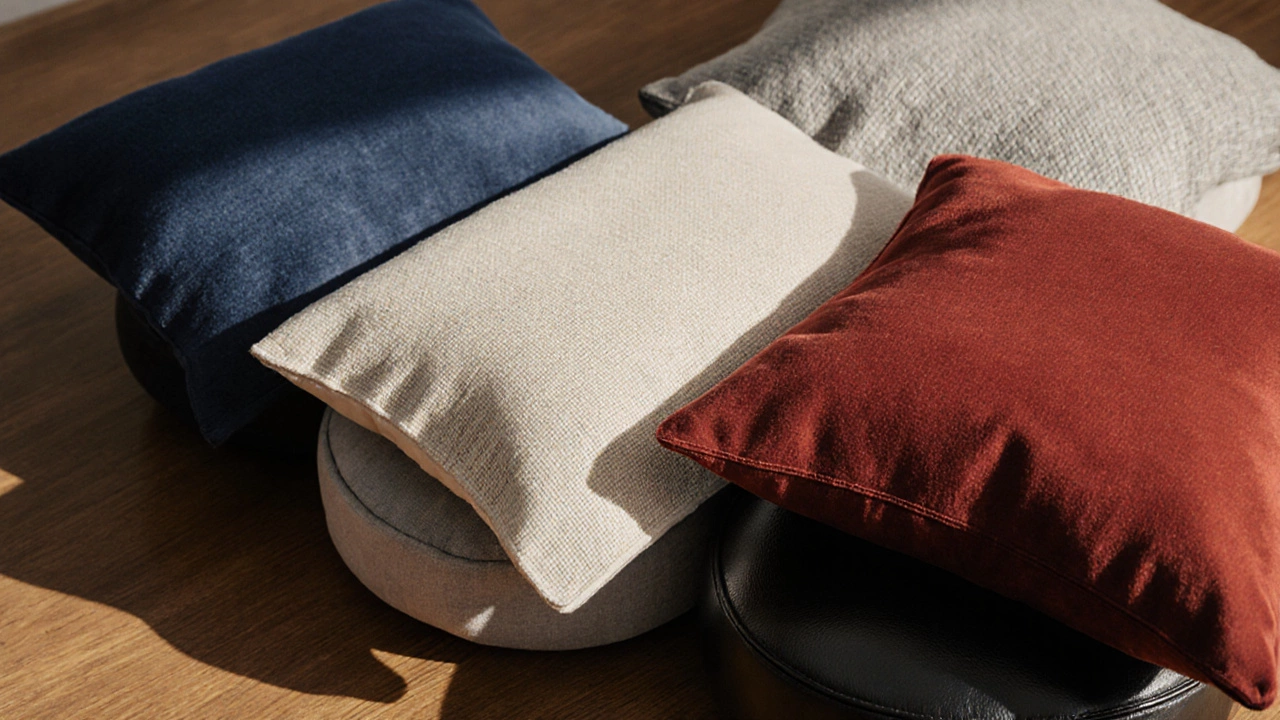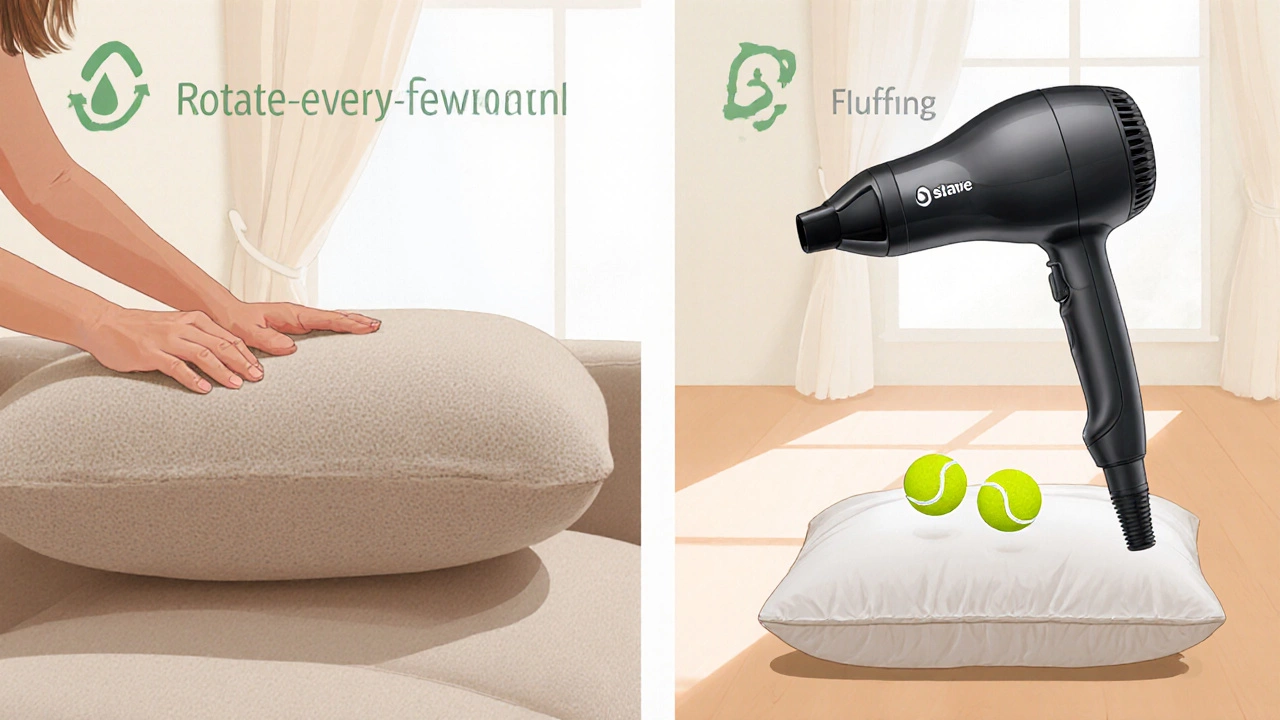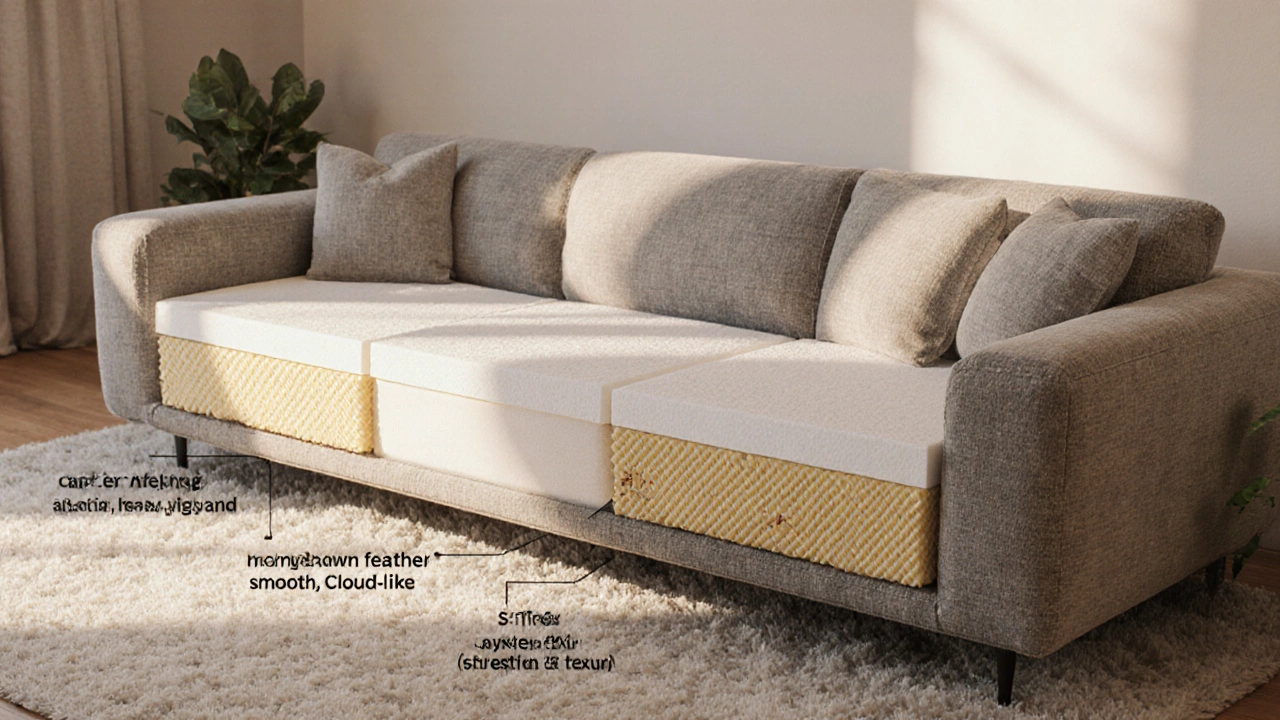Sofa Cushion Selection Calculator
Find Your Perfect Cushion Match
Answer these questions to get personalized recommendations based on your needs and lifestyle.
Your Personalized Recommendations
Top Recommendation
Why This Matters
The right cushion combination directly impacts your comfort, sofa longevity, and maintenance effort. A high-resilience foam core with microfiber cover, for example, provides excellent support for families with pets while being easy to clean.
When you sink into a new sofa, the first thing you notice is how the sofa cushions feel - springy, plush, or somewhere in between. Picking the right cushion type can turn a good sofa into a favorite spot for movie nights, naps, and chats with friends. Below you’ll find a no‑fluff rundown of cushion cores, cover fabrics, firmness levels, and care tips so you can match comfort to your lifestyle and décor.
What’s Inside a Cushion? Core Materials Explained
At the heart of every cushion is the filling that supports your body. Here are the most common core options, each with its own pros and cons.
- High‑resilience foam a dense, elastic foam that offers firm support and quick recovery. Ideal for families with kids because it bounces back fast after jumps.
- Memory foam a temperature‑sensitive foam that conforms to the shape of your body. Great for anyone who wants pressure‑point relief, though it can feel warm in summer.
- Down feathers lightweight natural fill that creates a cloud‑like softness. Best for a luxurious, sink‑in feel but requires regular fluffing.
- Polyester fiber synthetic fill that mimics down at a lower cost. A solid choice for budget‑friendly sofas that still need a soft touch.
- Latex foam a natural rubber foam known for durability and bounce. Perfect for eco‑conscious shoppers who want lasting support.
Each core material affects firmness, durability, and how the cushion reacts to temperature. Knowing these traits helps you decide whether you want a sofa that hugs you or one that holds you up.
Cover Fabrics: How They Influence Comfort and Longevity
The outer fabric does more than look pretty - it can change how the cushion feels and how easy it is to keep clean.
- Microfiber a tightly woven synthetic fabric that resists stains and pet hair. Ideal for busy households.
- Canvas or plain cotton - breathable and soft, great for casual settings but may show wear faster.
- Linen - offers a relaxed, natural look with good airflow, though it wrinkles easily.
- Velvet - adds a touch of elegance and feels plush, but it can attract dust.
- Leather - sleek and easy to wipe down, but can feel stiff when cold.
When you match a durable fabric like microfiber with a resilient core, you get a combo that lasts years with minimal upkeep.
Finding Your Ideal Firmness Level
Firmness is personal, but you can use a simple rule of thumb. If you tend to slouch, a softer cushion (down or polyester fiber) encourages a more relaxed posture. If you have back issues, a firmer core (high‑resilience or latex foam) provides better lumbar support.
- Sit on the sofa and note how deep you sink. Less than an inch? You’re on the firm side.
- Press the cushion with your hand. If it springs back instantly, you have a high‑resilience core.
- Try a quick bounce test - a soft cushion will flatten slowly, a firm one rebounds quickly.
Most retailers list cushion density (measured in pounds per cubic foot). Aim for 1.8-2.0lb/ft³ for firm support and 1.5-1.7lb/ft³ for a softer feel.

Maintenance Tips to Extend Cushion Life
Even the best cushions need a little love.
- Rotate cushions every 3‑4 months to prevent uneven wear.
- Vacuum fabric covers weekly; use the upholstery attachment.
- Spot‑clean spills immediately with a mild detergent and warm water. Test on an inconspicuous spot first.
- For down or feather cushions, give them a good shake or use a low‑heat dryer with tennis balls to restore fluffiness.
- Consider removable, washable covers if you have kids or pets.
By following these steps you can keep your cushions looking fresh for the lifespan of the sofa - typically 7‑10 years for high‑quality pieces.
Comparison of Popular Cushion Fillings
| Filling | Feel | Durability (years) | Maintenance | Typical Cost |
|---|---|---|---|---|
| High‑resilience foam | Firm, springy | 8‑10 | Rotate, spot‑clean | $$ |
| Memory foam | Medium‑soft, contouring | 6‑8 | Rotate, avoid high heat | $$ |
| Down feathers | Very soft, plush | 5‑7 | Fluff regularly, professional cleaning | $$$ |
| Polyester fiber | Soft, supportive | 5‑6 | Shake, spot‑clean | $ |
| Latex foam | Firm, resilient | 9‑12 | Rotate, low‑heat cleaning | $$$ |
Use this table as a quick reference when you compare sofas in store or online.

Quick Decision Checklist
- Do you need high durability for kids or pets? Choose high‑resilience or latex foam.
- Is a luxurious, sinking feel your top priority? Go for down or high‑quality polyester fiber.
- Do you have back pain? Opt for firm foam cores with a supportive fabric like microfiber.
- Do you want easy cleaning? Pair a synthetic core with microfiber or leather cover.
- Is budget a concern? Polyester fiber plus a cotton or canvas cover delivers comfort without breaking the bank.
Frequently Asked Questions
How often should I replace sofa cushions?
Most high‑quality cushions last 7‑10years, but the exact timeline depends on usage, material, and maintenance. If you notice permanent sagging, loss of shape, or fabric wear, it’s time for a replacement.
Can I mix different cushion fillings on the same sofa?
Yes. Many designers use a firmer core in the back cushions and a softer fill in the seat cushions for balanced comfort. Just make sure the covers match the overall look.
Is down better than polyester fiber?
Down feels lighter and more luxurious, but it’s more expensive and requires regular fluffing. Polyester fiber mimics down’s softness at a lower price and is easier to care for, making it a practical alternative.
How do I know if a cushion is high‑resilience foam?
Check the product spec - it usually lists "HR foam" or a density of 1.8-2.0lb/ft³. In‑store, press the cushion: a quick snap‑back indicates HR foam.
Can I wash the cushion covers myself?
If the cover is labeled removable and machine‑washable, yes - use a gentle cycle, cold water, and low heat drying. Otherwise, spot‑clean or hire a professional upholstery cleaner.





